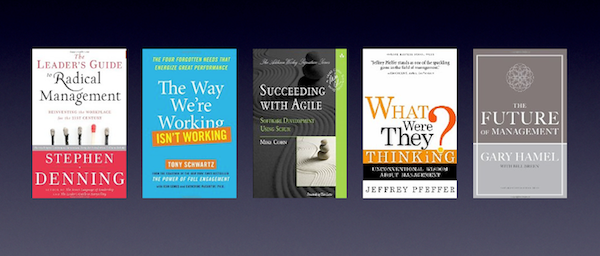Five principles to improve productivity, reduce churn & increase profits
Posted on 18. Nov, 2011 by ger in Leadership, New Ways to Work

Five books describing a new approach to business
There’s a revolution happening in the way businesses are being run. This post will distill five key principles of this transition from five “new approach” business books. These principles will help you increase productivity, reduce staff turnover and increase profits.
Many books and blog posts have been written about this new approach to business. Many present case studies from companies like Apple, Best Buy, Enterprise, Semco, Salesforce, and WL Gore. The Whole Foods Market story is profiled in Gary Hamel’s “The Future of Management”.
The Whole Foods Story
Whole Foods Market is made up of many empowered teams. Each team:
- Has autonomy and is in essence a small business inside the store
- Has freedom but is held accountable
- Transparently publishes their performance (profit/hour)
- Can veto new hires
- Can decide what to stock
Each store is benchmarked 10 times a year. The pressure to perform comes from peers not managers. This non-hierarchical structure means decision making is distributed and small problems don’t fester before being noticed and addressed.
While this might sound new-age and chaotic, Whole Foods Market is the most profitable food retailer in the US (per sq foot). Whole Foods Market rallies around a clear purpose. “We want to improve the health and well-being of everyone on the planet through higher quality foods and better nutrition. We can’t fulfill this mission unless we are highly profitable.”
Other Success Stories
Other companies have made similar radical transitions and seen performance improvements:
- Salesforce switched their product development to agile and increased productivity by 38% and doubled their revenues over a two year period
- WL Gore has $2B in revenues and has been run as an innovation democracy for 40 years
- Best Buy started a “results only work environment” and increased productivity by 41% and reduced staff turnover costs by 90%
- Thogus Products a small manufacturing company increased output 67%
These revolutionary techniques come labelled in many ways: radical management, future management, agile businesses and protean organizations. Whichever label you choose, companies that use these techniques are surviving and prospering. Companies who stick to the old techniques of cost cutting, salary reductions and layoffs lose productivity, customers and frequently enter a downward spiral from which recovery is extremely difficult.
The key principles
Empowered teams of engaged individuals
Scott Page studied groups solving complex problems and found a cognitively diverse group of people outperforms a group of like minded experts. Teams which are given autonomy and control perform better. When people at the grassroots of the organization have a clear line of sight to customers they can see how they are contributing to the organizations goals.
Delivering true customer value
Unhappy clients can damage a brand. People with a line of sight to the customer feel more motivated. The meaning of their work is not the toy they’re assembling or the profit the company will make, but the delight on the face of a child. Companies like Enterprise have used net promotor scores to delight customers and turnaround their business. In contrast, David Carroll’s YouTube video “United breaks Guitars” has been watched over 11 million times (at the time of writing).
Using short iterations value adaptability over predictability
Projects with long timelines and complex Gantt charts repeatedly miss budgets and deadlines. The iterative approach was used to great success on Polaris submarine program in the 1950’s and 1960’s. By reducing the amount of work in progress and breaking large projects down into four weeks long or smaller iterations, teams can become far more effective.
Information radiators
Lack of management transparency has resulted in a number of disasters. Problems are brushed under the carpets. Well-meaning questioning is rooted out as dissent. When teams create dashboards to show progress there’s no need for status reports. Anyone can see information about the project. The best performing organizations have universal accountability.
Introspection and action
It’s hard to imagine how stopping a production line for a defect could be a good idea, but it is. The team must first recognize reality and the issues that exist but that’s less than half the battle. Taking remedial action is usually the hard part. Changing people’s behavior to fix systemic issues is even harder.
- “Implementing continuous self-improvement requires a fundamentally different kind of mind-set from traditional management. It involves creating an environment in which the organization draws on the full talents and capacities of the people who work there… It’s about powering up the internal energy of teams so that they transcend their limitations and create products or services that generate client delight.” – Stephen Denning
The time to act is now
Maybe you’re thinking “yes this is important, we’ll do something about it soon.” Maybe you’re too busy. If your business is not improving it’s standing still. Companies who delay will: miss opportunities, lose customers, and be outmaneuvered by nimble competitors.
Learn more
Thank you for reading. We hope you found something useful. Please try Goshido, our collaboration & project management platform. Goshido can help you and your teams to apply new business principles to improve productivity.
If your company is an Enterprise Ireland client you can avail of training and support to introduce Lean and Agile techniques to your business.
Some books we recommend
Here are links and summaries to some great books on the “new approach” to business.
Stephen Denning’s book The Leader’s Guide to Radical Management applies agile techniques to the organization as a whole, not just a single team or the product development group. Denning translates Agile and Scrum from software development into general business terms.
The Way We’re Working Isn’t Working by Tony Schwartz, Jean Gomes and Catherine McCarthy creates a road map for a new way of working. At the individual level, they explain how we can build specific rituals into our daily schedules. At the organizational level, they outline new policies and practices that energize great performance.
In Succeeding with Agile, Mike Cohn describes success factors in applying an agile technique called Scrum in your organisation. It is mainly written from a software development perspective but there’s some valuable suggestions on team dynamics and the need for enlightened leadership. Chapters 10 and 12 describe the mind shift needed to become a “servant leader” of self-organizing teams.
Gary Hamel in The Future of Management makes the case that management innovation fuels long-term business success. He profiles a number of companies who have successfully reinvented management for their organizations.
In What Were They Thinking?: Unconventional Wisdom About Management, Jeffrey Pfeffer describes conventional business wisdom and the problems it can cause. He focuses on three common themes: understanding feedback effects, self-managing teams, and avoiding overcomplication.
Slides from Agile Tour 2011 – Principles of Scrum
Posted on 07. Nov, 2011 by ger in Events, New Ways to Work
A couple of weeks ago I spoke at AgileTour Dublin 2011. AgileTour aims to communicate the benefits of Agile for businesses and create leaders in Agile in all regions of the world.
I spoke about getting started and improving your organization using Scrum. You can get my slides from our website.
Other speakers included Colm O’hEocha from AgileInnovation, Fran O’Hara from Inspire Quality Services, Robert McGarry from Ignition Team, Richard Bowden from Cloud Consulting, and Alan Spencer from D&B. You’ll find details of the other talks on the Agile Tour website. Alan was speaking at the same time as me, so I missed his talk. From his slides it looks like he was discussing the benefits of Agile for business in general, a subject that’s close to our hearts too.
Thank you for reading
We hope you found something useful. Please try Goshido, our collaboration & project management platform. Goshido applies new principles for how work can be organized; the perfect blend of Agile, Lean, Productivity and Attention Management.
JiveWorld Recap: Social Project Management is Here to Stay
Posted on 14. Oct, 2011 by tom in Events, New Ways to Work
At JiveWorld 2011 we learned some key insights into how the world of work is being transformed by technology. We also demonstrated the integrated Goshido Jive application which combines the best of both products. Among the audience I could sense a tangible belief that we are at the cusp of one of the most important technology & management transitions ever seen. The companies who make this transition will be more agile and successful than the ones who don’t.
Jim Worth has put together a wiki summarizing many aspects of JiveWorld. Jive will be making videos & presentations available in the near future. In this post we’ll focus on the key takeaways from the Goshido point of view:
- The people are the platform:
This was the message of Wednesday’s keynote, and we couldn’t agree more. Even in the most regimented businesses, people are still THE competitive differentiator. Jive really is about engagement, sharing and discovery. Goshido is about action. One plus one, in this case, can lead to a very significant sum.
- Jive’s customers are committed:
Everyone we spoke with was committed to improving the way work gets done in their businesses. This might mean changing process, or culture.
- It’s not either/or:
We were wondering if companies were using Jive for internal or external social business processes. It turns out that there were a wide mix of use cases, befitting the mix of industries and functional groups represented. Sometimes internal collaboration is the goal, sometimes customer facing opportunities are being addressed. In some cases companies are doing both. For example, Patrick Darling of Intel described how they built Intel Newsroom, a super-successful community-based news hub. Newsroom makes Intel’s PR faster to deliver, more social and easier to search.
- Adoption is still a challenge:
For both project management and social business solutions, the key is adoption. The not-so-good news is that there is still resistance to change. The really good news is that there is plenty of momentum and lots of room for improvement.
- The new system of record:
The alphabet soup of traditional business software extends from ERP to CRM. Jive Software is more people centric. Jive has re-imagined business communication from the ground-up to help you unlock business value in the social capital of your enterprise. Jive can become the new “system of record”, business software that’s as easy to use as consumer web applications. We believe Goshido can extend Jive to become the “system of action” for your organization.
- ROI is top of mind:
Many Jive customers reported significant returns on their investment in social business technology. This is a transition that has quantifiable benefits. For example, Dianne Kibbey spoke about how Premier Farnell created a thriving community for electronic design engineers.
- Innovations and customer centric-engineering:
In the Thursday keynote, Jive demonstrated some of the coming innovations in the platform. In a nice touch, the product development team stood up and gave a round of applause to the many customers in the room. It turns out the whole team had flown in the night before and spent the following day talking to customers at presentations, lunch and demos.
Thank you for reading
We hope you found something useful in this post. Please try our product Goshido, the project collaboration & management solution designed for the people who do the work. Teams all over the world are using Goshido to get work done. When everyone on your team is focused on the things that matter, work flows and you can accomplish the extraordinary.
Goshido + Jive: Making Project Management Social
Posted on 05. Oct, 2011 by tom in Events, New Ways to Work, Product, blog
There’s a revolution happening in the way businesses are being organized. Traditional command-and-control hierarchies are evolving into an emergent-and-adaptive network of people working across organizational boundaries. The best performing organizations have universal accountability. Goshido helps organizations be more agile and naturally accountable.
This week we’re at JiveWorld where we’re showing our latest integration, which connects Goshido with the Jive Software platform. This integrated offering will soon be available in the Jive Apps Market, and we’re convinced that it will help advance our goal of transforming how knowledge workers engage and collaborate.
A great idea in a Jive discussion could become a complex project for an entire team, executed in Goshido. Knowledge work projects don’t always follow pre-programmed roadmaps, but most project management solutions are designed as if they do. With Goshido, anyone can connect actions together into projects that can evolve and grow.
Goshido is project management for people who are doing the work. Unlike traditional project management solutions, Goshido scales to handle complex projects while remaining easy to use. Most project management solutions focus on planning. Goshido helps you focus on execution.
The nature of work has changed. Goshido helps you keep pace with that change. Our software helps teams to execute projects – to keep all the moving parts moving. Hundreds of teams all over the world are using Goshido to get work done. When everyone on your team is focused on the things that matter, work flows and you can accomplish the extraordinary.
Thank you for reading
We hope you found something useful. Please try Goshido, our collaboration & project management platform. Goshido can help you and your teams to take action in the absence of orders and communicate with clarity.
Project Collaboration Roundup: structured fighting, project timebombs, productivity guidelines & Enterprise 2.0
Posted on 23. Sep, 2011 by tom in Guides, New Ways to Work, Roundup, blog
We know that it’s hard to stay on top of all of your activities. That said, it’s rare that we think of our projects as ticking time bombs. This week we have some useful rules and advice about productivity, and lots of good thinking on collaboration and new ways of working socially.

John Morehouse by KrissZPhotography
Clay Shirky on collaboration: structured fighting
In a story by Joe Brockmeier posted on ReadWriteWeb, a talk by the always thought-provoking Clay Shirky hits on some important points, and an interesting metaphor. As we like to preach here at Goshido, large projects are really made up of lots of small projects, and lots of actions.
Are your projects out of control?
First, the bad news. According to a study conducted by Professor Bent Flyvbjerg, BT Professor and Founding Chair of Major Programme Management at the University of Oxford one in six projects are “out of control.” Late, over budget, and out of control is no way to go through life. When I saw the phrase “ticking time bomb,” I certainly took notice.
Perhaps some rules for productivity would help?
A presentation from Dan at Lostgarden covers eight common workplace topics and how you should approach them. It’s important to remember that productivity is more than just more units produced per unit worked, and the pdf or powerpoint (take your pick) provides some strong guidance.
The Big Failure of Enterprise 2.0 Social Business – by Laurie Buczek
And ideas about how to fix it from the trenches. Three key takeaways:
- Focus on creating a natural collaborative experience
- Focus on providing an easy & intuitive user experience
- Focus on dissolving collaborative islands- don’t create more with social tools
Thank you for reading
We hope you found something useful. Please try Goshido, our collaboration & project management platform. Goshido can help you and your teams to take action in the absence of orders and communicate with clarity.
Photo by KrissZPhotography, available under a Creative Commons attribution license
The Four Principles of Leadership
Posted on 20. Sep, 2011 by tom in Leadership
In a recent post “The Monk and the Knowledge Worker” Donal told an old story about a Buddhist monk. Now it’s time to tackle some leadership lessons from another “old company,” this time the Jesuits.

In his book Heroic Leadership, Chris Lowney analyzes what he calls the four pillars of success:
- Self-awareness: understand your strengths, weaknesses, values, and worldview
- Ingenuity: confidently innovate and adapt to a changing world
- Love: engage others with a positive attitude that unlocks their potential
- Heroism: energize yourself and others with heroic ambitions and a passion for excellence
As you might expect from an author who is both a former Jesuit and investment banker, the lessons from the book manage to be both manifold and on-point for the challenges we face in business today. If you think cracking China is hard today, imagine how hard it was four centuries ago? But using their core leadership principles, the Jesuits managed achievements that were truly heroic.
Stripping away any positive or negative biases, the lessons of the Jesuits can be seen in the works of experts as diverse as Peter Drucker or Daniel Goleman. Drucker on the knowledge economy and worker, and Goleman on managerial self-awareness (his 5 core competencies: self-awareness, self-regulation, motivation, empathy, and social skill).
Working in a world with lots of everyday distractions (aka information overload) awards a high value to those who can effectively tune out those distractions and focus on the key goals at hand. One way to make ambitious goals manageable is to break them down into smaller goals. Lowney even invokes the challenge of kicking a smoking habit, the same metaphor captured in the title of David Maister’s wonderful book “Strategy and the Fat Smoker.”
We spend so much time looking forward in business today that sometimes we forget that there’s still much to be learned by looking back. Clearing the clutter – understanding clearly what you need to do and what you need to know – can free you to be more productive, and perhaps even heroic.
Reading list:
- Chris Lowney, Heroic Leadership
- David Maister, Strategy and the Fat Smoker
- Peter Drucker, The Essential Drucker
- Daniel Goleman, Emotional Intelligence
Thanks for reading
Please try Goshido, our collaboration & project management platform. Goshido can help you and your team to make ambitious goals manageable by breaking them down into smaller goals.
Photo by Brian Jeffery Beggerly, available under a Creative Commons attribution license.
Cloud Computing Demystified
Posted on 15. Sep, 2011 by ger in Guides, New Ways to Work
Cloud computing can have huge benefits for a business of any size. If you’re running a small business you can share information and use world class software without up front costs. If you’re a large business you can consolidate complex applications onto less hardware, run them on someone else’s computers and access them over the internet.

I am one of the panelists at the Irish Executives conference in Galway Ireland on 15-Sep-2011. Here are some resources (articles, videos and books) that might help you learn more about the cloud software and how it can benefit your business.
Thank you for reading
We hope you found something useful. Please try Goshido, our collaboration & project management platform. Everyone is a project manager these days. Goshido helps teams of all shapes and sizes to get things done.
If you trial Goshido using the link above, you’ll get a 40% discount for you and your team if you decide to purchase.
Photo by barto, available under a Creative Commons attribution license
Project Collaboration Roundup: staying focused, wishing & planning, startup execution
Posted on 05. Sep, 2011 by ger in Roundup
Are you or your projects in a state of a) constant interruption b) constant wishing or c) constant churn? Here’s some interesting posts and articles we found on the interwebs recently.

Wall of Lemons by psd
How to Stay Focused in an Age of Constant Interruption
The psychologist Dr. Elisha Goldstein describes how you can minimize the constant interruptions in the modern workplace. He suggests:
- Schedule un-interruptible time on your calendar
- Earplugs
- The mindful check-in
“It Takes as Much Energy to Wish as it Does to Plan”
Over at lifehacker Adam Dachis expands on the above quote from Eleanor Roosevelt.
-
“If you find you’re spending a lot of time thinking about doing something, turn it into a plan. You don’t necessarily have to act on that plan, but if you decide to you’ll be ready.” – Adam Dachis
For startups (and larger companies) it’s all about execution
Over on Forbes, Martin Zwilling summarizes the keys to business excellence for startups. He’s summarizing a book called The Power of Convergence by Faisal Hoque. Faisal’s book is focused mainly on larger enterprises and making them more agile.
-
A startup begins with a great idea, but all too often, that’s where it ends. Ideas have to be implemented well to get the desired results. Good implementation requires a plan, and a good plan and good operational decisions come from good people.
Here’s a selection of the “repeatable practices to maximize business opportunities” Martin identifies
- empower people to take action in the absence of orders
- communication is critical
- formulate and recognize when Plan-B needs to happen
This post reminded me of Derek Sivers’ classic Ideas are a Multiplier of Execution.
Thank you for reading
We hope you found something useful. Please try Goshido, our collaboration & project management platform. Goshido can help you and your teams to take action in the absence of orders and communicate with clarity.
Photo by psd, available under a Creative Commons attribution license
Project Collaboration Roundup: improve focus, killer coworkers, agile WBS
Posted on 19. Aug, 2011 by ger in New Ways to Work, Roundup

Brain Coral (by Laszlo Ilyes)
Do you want to a) improve your focus at work b) live longer c) connect your agile projects into a larger project WBS? Here’s some interesting posts and articles we found on the interwebs recently.
Understand how your brain works and improve your focus
In this Google Tech Talk, David Rock describes how our brains work at work. He shows why we get distracted and describes some things you can do to improve your focus and reduce stress at work. David Rock is the author of “Your Brain at Work”.
The correlation between co-workers and mortality
In Wired, Jonah Lehrer asks “Are your co-workers killing you?” A recent study from Tel Aviv University has found a correlation between “the perceived niceness of co-workers” and the risk of death. It seems your co-workers are more influence than your boss. The study tracked 820 people over a twenty year period and found;
- “people with little or no “peer social support” in the workplace were 2.4 times more likely to die during the study, especially if they began the study between the ages of 38 and 43. In contrast, the niceness of the boss had little impact on mortality.
Jonah also mentions a larger UK study which tracked 28,000 government workers since 1967. That study linked the person’s “perception of control” with their work peer social support and mortality. Jonah summarizes the outcome:
- “the only thing worse than an office full of assholes is an office full of assholes telling us what to do.”
In July on this blog Donal discussed the knowledge worker’s perception of control. I wonder if social business platforms like Jive could be good for your health? Maybe our product Goshido can increase “perception of control” for your team (and lengthen their lives)?
Connecting Agile projects to Work Breakdown Structures (WBS)
Glen B. Alleman on the HerdingCats blog, describes how you connect agile projects with the WBS of large projects like US federal government contracts. He links the agile taxonomy of work to the traditional WBS.
- Agile Epics correlate to WBS Program Events
- Agile User Stories correllate to WBS Accomplishment Criteria
- Agile Features correlate to WBS work packages
- Tasks are the same in both Agile and WBS
Here at Goshido we believe there can be more than four layers in a project.
- “Agile does a good job of defining the outcomes of each iteration, and managing the contents of those iterations during the Planning process. What is needed is an upper level process.”
Thank you for reading
We hope you found something useful. Please try Goshido, our collaboration & project management platform. Goshido can help you and your teams work better together (and maybe help you live longer).
Project Collaboration Roundup – leading change, teamwork groundrules
Posted on 05. Aug, 2011 by ger in New Ways to Work

Seeds of Change (by Clearly Ambiguous)
We’re now in the quiet weeks of August, what better time to recharge the batteries and think a bit more strategically about your business? Here’s some interesting posts and articles we found on the interwebs recently.
If you want to lead deep organizational change
Steve Denning outlines the four story types you need. By way of example he uses “leaders and managers have to unlearn the management practices that were so successful in the 20th Century but so unsuccessful today.”
- We now know precisely how unproductive traditional management is—declining rate of return on assets (one quarter of what it was in 1965), declining life expectancy of firms in the Fortune 500 (less than 15 years) and lack of engagement of workers (only one in five workers is fully engaged in his or her work.)
It’s not enough to quote facts and statistics though. It’s not enough to force people to change by dictat. It’s not enough to send a pep talk email to everyone in the organization or film a town hall meeting.
- Prose remains unread. Dialogue is just too laborious and slow. By contrast, leadership stories can get inside people’s minds and affect how they think, worry, wonder, agonize and dream about themselves and in the process create – and recreate – their organization.
If you’re wondering what kinds of career paths will be of value in the coming decade
Lynda Gratton on the CorkBIC newsletter suggests Grassroots Advocacy, Social Entrepreneurship and Micro-Entrepreneurship. This will bring real challenges in terms of coordination and project management:
- they will be part of a much larger collaboration of many thousands of people brought together to experience economies of scale. Whatever the mechanism of coordination, we can expect a greater proportion of the valuable work in companies to be carried out by people working independently.
If you are interested in some simple groundrules for teamwork
Kristóf Kovács published three simple principles for effective teams:
- ASK: If a task is not clear
- DEBRIEF: It’s not done until you reported it done
- WARN: If a deadline you know is important will likely be missed
More details on his site. It’s all about clear communication.
If you’re in Ireland and you’re interested in Agile Quality Strategies
SoftTest are organizing a couple of events in August on 10th (Belfast) & 11th (Dublin). David Evans an uber experienced agile coach and consultant will be talking about agile testing and quality. The event is free and sponsored by InterTrade Ireland, Sogeti and Software Skillnet.
Thanks for reading
We hope you found something useful. If you’re interested in a collaboration / project management platform that can guide your teams to be more effective, check out Goshido.

